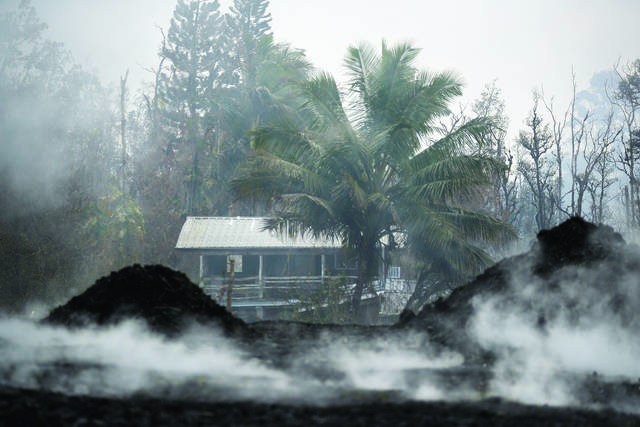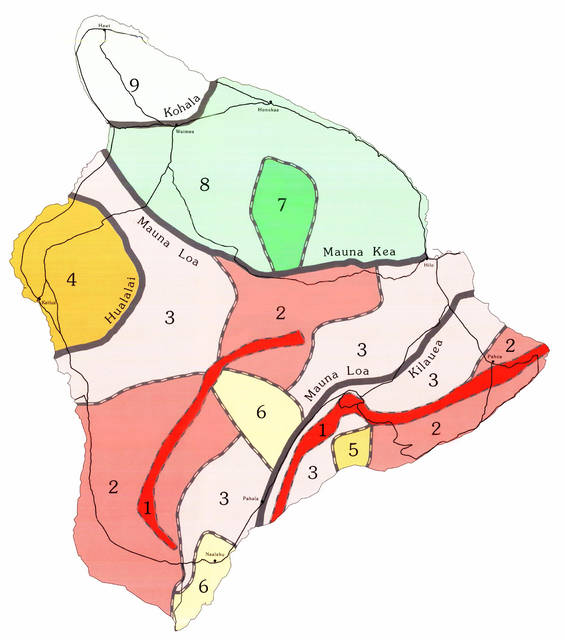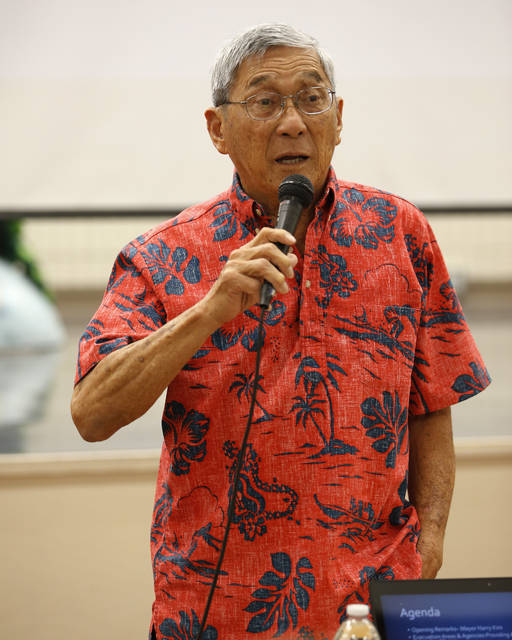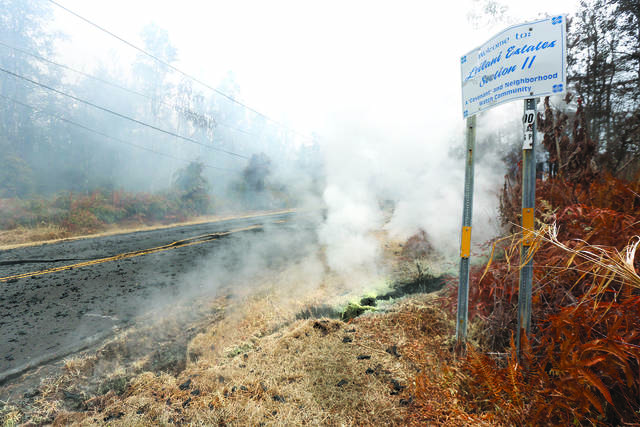Kim: Don’t bar building in lava zones




HILO — Because so much of Hawaii Island geography is designated as lava zones 1 and 2, it doesn’t make sense to bar construction there, Mayor Harry Kim said Tuesday.
HILO — Because so much of Hawaii Island geography is designated as lava zones 1 and 2, it doesn’t make sense to bar construction there, Mayor Harry Kim said Tuesday.
Kim, reacting to public statements by state officials, said construction can’t be restricted in those two zones with the highest risk of inundation without compensating property owners for the loss of use of their lands. Lava zone 2, for example, includes a large swath of Puna and most of southwest Hawaii Island, including Hawaiian Ocean View Estates, considered the largest private subdivision in the nation, with 11,500 1-acre lots over 18 square miles.
“These are our bedroom communities. A lot of people purchase there because they want to live there, but a lot of people live there because that’s the only place they can afford,” Kim said after a County Council briefing of short- and long-term plans for housing in the midst of an eruption in lower Puna.
Instead, Kim said, his administration can, and will, deny rezoning to higher density developments in those two lava zones. Recommendations on rezoning applications are made to the planning commissions by the planning director, which then forward their recommendation to the County Council.
“I wish there was a simple answer,” Kim said, noting that the lava-flow hazard zones were set by the U.S. Geological Survey in the 1980s, while the subdivisions were created in the 1950s and ’60s.
Gubernatorial front-runners incumbent Gov. David Ige and challenger U.S. Rep. Colleen Hanabusa, as well as incumbent District 4 state Sen. Lorraine Inouye, all Democrats, in recent political forums have advocated construction restrictions in the lava zones most at risk.
The County Council heard from department heads explaining the process of creating emergency, short-term and long-term housing for residents of the 700-plus homes that have been destroyed and another 15 made inaccessible since lava started flowing across lower Puna on May 3.
There are still 219 people in shelters in Pahoa and Keaau, where there was at one time a high of 485, said Parks and Recreation Director Roxcie Waltjen. The evacuees are being interviewed through today to determine what are the barriers to them moving into more long-term shelters. The number of tents at the Pahoa site have dwindled by half, she said.
The county is working with the Federal Emergency Management Agency for intermediate housing solutions. Some 2,000 people have registered with FEMA for some kind of assistance, said Executive Assistant Roy Takemoto.
Working with faith-based and nonprofit organizations, the county has seen 20 transitional micro houses built with 20 more on the way, with another 50 being planned in Pahoa, he said. The county is also scouting out areas for more housing, such as near the Panaewa equestrian center.
The county is looking at a number of options for housing during the 18 months that FEMA provides assistance, Takemoto said. With FEMA paying 75 percent to the county’s 25 percent, options include hotels, allowing accessory dwelling units such as ohana structures, refurbishing public housing units that currently stand vacant and working with the real estate industry to identify the housing inventory available for rentals and ownership, he said.
Takemoto said the county is also looking into creating a redevelopment agency and revising the tax code to make federal Section 8 vouchers and county affordable housing more attractive to landowners, especially in West Hawaii.
While tragic, the lava inundation offers the county a unique opportunity to create communities from scratch, planning officials said. Creating walkable town centers at subdivisions with transit hubs and schools, creating agricultural parks with clustered housing, infrastructure and shared processing facilities are among the long-term possibilities.
Puna Councilwoman Eileen O’Hara, who represents the district hardest hit by lava, wanted more specifics on propping up local businesses and building more housing.
O’Hara said her district needs something more concrete than “just nice imagery of walkable towns.”
“Recovery isn’t just about housing. It’s also about rebuilding the district,” O’Hara said.
It still takes nine to 12 months to get a building permit, she said. The district needs economic development measures such as lava observation platforms or tour buses, she said.
“We have lost tons of jobs,” she said. “We’ve got to move a little faster to address the needs of the folks who are impacted by this.”



Well, it’s one thing to bar construction in broad zones which probably overreach, and another to use some common sense judgement. Like not allowing a large housing subdivision to be built between the lava flows of 1955 and 1960 in a rift zone, where Vacationland and Kapoho stood.
I am OK with letting people build in those zones however we should be able to exclude them being made whole by taxpayer monies in the event of a disaster moving forward. I am not about controlling peoples lives or ability to make good or poor decisions, I just do not want to pay for them.
“Insanity”=doing the same thing over and over and expecting different results and getting the same results. Kim is a shiftless grifter in the pocket of the developers who want to build in the most dangerous active lava zone in the world. All of lava zone 1 and 2 and maybe 3 should be condemned and given gratis to Volcanos National Park. Anyone currently living there should be given the choice to move or given tickets to the mainland. This idea of more building in the rift zone is total lunacy. I am not surprised since to these liberal socialist commies government is always the answer. Remember that these shiftless grifters got rich and wealthy by selling worthless land to fools who had no idea of the risks involved. Then they insure the worthless land with government help thereby creating an entire class of dependents who then expect the hard working taxpayers to bail them out when the inevitable happens.
Because no one who got their home or land taken was hard working? What a joke your comment is, you do realize 1/2 of Hilo and most of South Kona are lava zone 3? Pull your head out of your ‘okole.
Wait, Ocean View is a bedroom community?
Hawaii County the best insurance policy out there. Can’t get homeowners insurance due to risk? Not to worry, build and Harry Kim with taxpayers money will bail you out.
One thing the County could do to help steer future development in lava zones 1 & 2 would be to make changes in the building and land use codes to allow people to build simple, low-cost basic shelter or moveable homes. Such changes would preserve much-needed affordable buildable properties, and they would provide people a way to either limit the amount of money at risk of future loss or to hitch up their hale and move to safer ground when Madam Pele appears likely to visit. I think that the tiny homes currently being built in Pahoa as temporary housing might be a good template for simple structures. There are two national standards that govern the construction of RV trailers and Park Model trailer cabins. Small builders across the country are able to build to these standards, and there is no reason that we couldn’t see such a shop open up here on island–if we were to define where people would be allowed to live in such homes. These trailers can be financed as personal property, so they can be afforded by many people. Moveable homes would also allow people to bring their own homes to an emergency shelter zone–think RV park. While it is true that making such a change to the County codes wouldn’t solve the development problem by itself, it would create the necessary regulatory framework to allow entrepreneurs to get busy and creating solutions that work in the marketplace, while also mitigating public costs in future lava inundation events.
This is insane logic and the same used on the mainland in areas prone to flooding. Taxpayers should not be bailing out people making bad decisions. Lava 1 and 2 are very high risk and should be avoided unless those taking the risk assume all of it.
I believe Zone 1 should be limited and I like what @Br@brdyp:disqus suggested with loosening building requirements. Its rediculous that we dont allow this period, but even more so in these areas.
This type of home has been allowed accross the country for decades, in hurricane states, tsunami states, frigid cold states, extreme heat states….. In fact I dont know of another state other than Hawaii that outlaws them. It would take care of so many other “housing” issues also.
Denser residential parcels in Zone 3+ areas is the way to go — not by permitting tiny houses and shacks in dangerous areas. We need open spaces to do actual food production and for tourism. It’s an obvious contradiction to have little money yet high desires for acreage, safety, utilities, services on an ISLAND.
There may be a legitimate debate about whether property owners should be able to build in high risk lava zones. But let’s recognize that no one has any reason, any longer, to misunderstand the danger of building in these zones. So, if you own property and build in these zones, you should bear the entire risk of doing so. You have no right to demand assistance from taxpayers if a future lava flow destroys your home. Nor should you receive insurance the rest of us subsidize. If you want to make risky, irresponsible financial decisions, you should bear the entire risk.
I’m guessing you live in North Kohala, about the only district with no lava risk though some risk of flooding, erosion, and earthquake damage. Now that I think about it, we should ban building everywhere on the island, based on your logic.
Actually, you misunderstood me. I think you should be able to build in high risk lava zones (which, incidentally, do NOT cover the entire island). I only think that if you decide to build in an area with a known, extreme risk, you should bear the responsibility for insuring your property and not rely on the rest of us to defray the cost of your risky decision if the lava flows your way. Build away, but don’t send us the bill if your risky decision goes wrong.
My apologies then. In all these areas people could get insurance and the County certainly WILL NOT be bailing these people out who don’t have insurance. FEMA won’t be doing that either. There were no eruptions in the lower east rift zone between 1840 and 1955, a time during which there were many on the Kona side. Hualalai and Mauna Loa are both overdue, so I’d categorize anything on their slopes as extremely risky. The nature of insurance of course is that everybody subsidizes it, and the insurance companies make a killing, just as they will have even after paying for Puna claims.
How about limiting building to an RV (Motor home, Travel Trailer, 5th wheel, etc) or semi pulled trailer that can be pulled out in 24 hours notice. TIny homes built on trailer frames would also qualify. Heat and cooling needs are minimal, so solar panels with batteries and water/sewer hookups should suffice.
I agree with Kim, but also think the County should not be building things itself or allowing commercial development as they’ve done right in Pahoa. Many of us moved here knowing commercial development wouldn’t be happening and it would stay sparse and peaceful. We got Long’s, KFC, Burger King, and now more awful chains are coming to a huge development that will eliminate what little character Pahoa had left. It will also make living in all the zones 1 and 2 near Pahoa more convenient. I didn’t move here for that. I moved here knowing the closest real town was Hilo. Aside from the bare minimum County and State facilities to provide power, water, police, fire, and ambulances, authorities should not be promoting more people moving to lower Puna as they have. However, they absolutely would need to compensate commercial property owners if such bans are put in place. I know if they banned building on the undeveloped lot I own next to my house, I would certainly sue unless compensated.
Citizen to Kim: don’t ask us to pay up if damages occur!